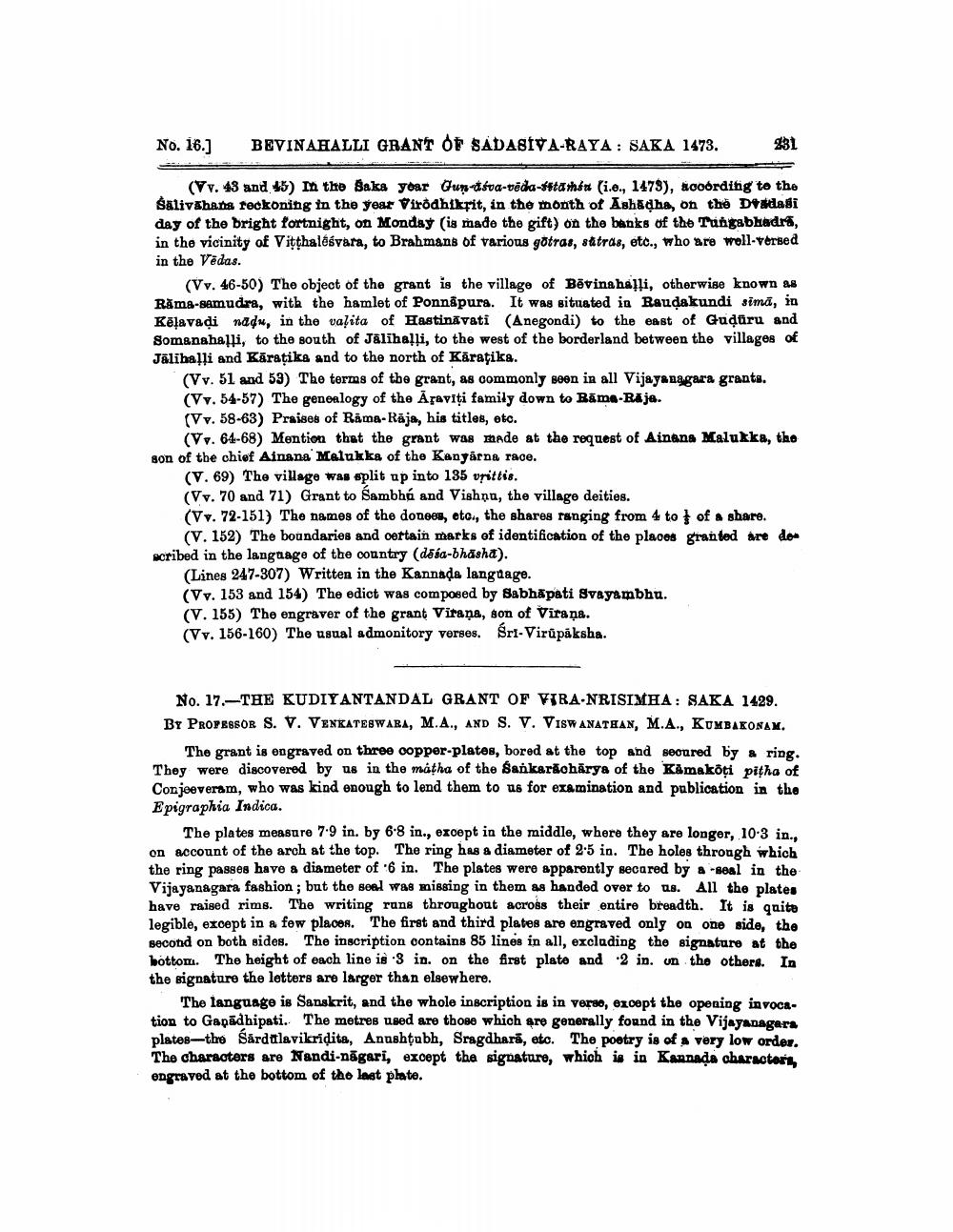________________
No. 16.
BEVINAHALLI GRANT OF SADABIYA-RAYA: SAKA 1473.
331
(Vv. 43 and 45) in the Baka yoar Gundsva-tēdha-##tanhin (i.6., 1479), nooording to the saliv hans reckoning in the year Virodhikrit, in the month of Ashadha, on the Dadasi day of the bright fortnight, on Monday (is made the gift) on the banks of the Tungabhadra, in the vicinity of Vitthalésvara, to Brahmans of various gotras, satras, etc., who are well-Tersed in the Vēdas.
(Vv. 46-50) The object of the grant is the village of Bēvinahalli, otherwise known as Răma-samudra, with the hamlet of Ponnapura. It was situated in Raudakundi simā, in Kēļavadi nadu, in the valita of Hastinávati (Anegondi) to the east of Gudaru and Somanahalli, to the south of Jālihalli, to the west of the borderland between the villages of Jäliballi and Kāraţiks and to the north of Käraţika.
(Vv. 51 and 53) The terms of the grant, as commonly seen in all Vijayanagara grants. (Vy. 54-57) The genonlogy of the Apaviți family down to Bama-Raja. (Vv. 58-63) Praises of Rama-Rāja, his titles, etc.
(V. 64-68) Mention that the grant was made at the request of Ainana Malukka, tho son of the chief Ainana Malukka of the Kanyårna race.
(V. 69) The village was split up into 135 vrittis. (Vv. 70 and 71) Grant to Sambhs and Vishnu, the village deities. (Vy. 72-151) The names of the donoes, etc., the shares ranging from 4 to of a share.
(V. 152) The boundaries and certain marks of identification of the places granted are do scribed in the language of the country (dssa-bhasha).
(Lines 247-307) Written in the Kannada language. (Vv. 153 and 154) The edict was composed by Sabhāpati Svayambhu. (V. 155) The engraver of the grant Virana, son of Virana. (Vv. 156-160) The usual admonitory verses. Sri-Virupaksha.
No. 17.-THE KUDIYANTANDAL GRANT OF VIRA-NRISIMHA: SAKA 1429. BT PROPESOR S. V. VENKATESWARA, M.A., AND S. V. VISWANATHAN, M.A., KUMBAKONAM.
The grant is engraved on three copper-plates, bored at the top and secured by a ring. They were discovered by us in the matha of the Sankarãohārya of the Kimakoti pitha of Conjeeveram, who was kind enough to lend them to us for examination and publication in the Epigraphia Indica.
The plates measure 7-9 in. by 6.8 in., except in the middle, where they are longer, 10-3 in., on account of the arch at the top. The ring has a diameter of 2.5 in. The holes through which the ring passes have a diameter of 6 in. The plates were apparently secured by a seal in the Vijayanagara fashion ; but the seal was missing in them as handed over to us. All the plates have raised rims. The writing runs throughout across their entire breadth. It is quite legible, except in a few places. The first and third plates are engraved only on one side, the second on both sides. The inscription contains 85 lines in all, excluding the signature at the bottom. The height of each line is 3 in on the first plate and 2 in. on the others. In the signature the letters are larger than elsewhere.
The language is Sanskrit, and the whole inscription is in verso, except the opening invocation to Gapādhipati. The metres used are those which are generally found in the Vijayanagara plates-the Sárdalavikridita, Anushţubh, Sragdhară, etc. The poetry is of a very low order. The characters are Nandi-nāgari, except the signature, which is in Kannada character engraved at the bottom of the last plate.




